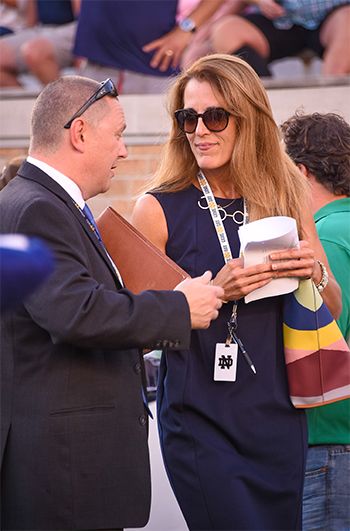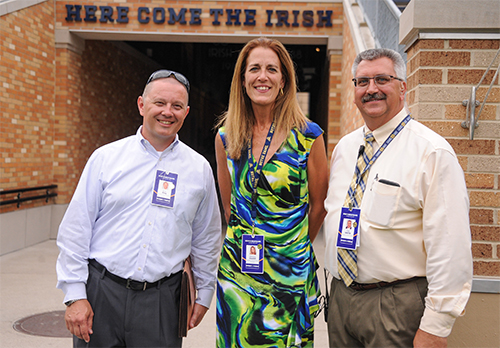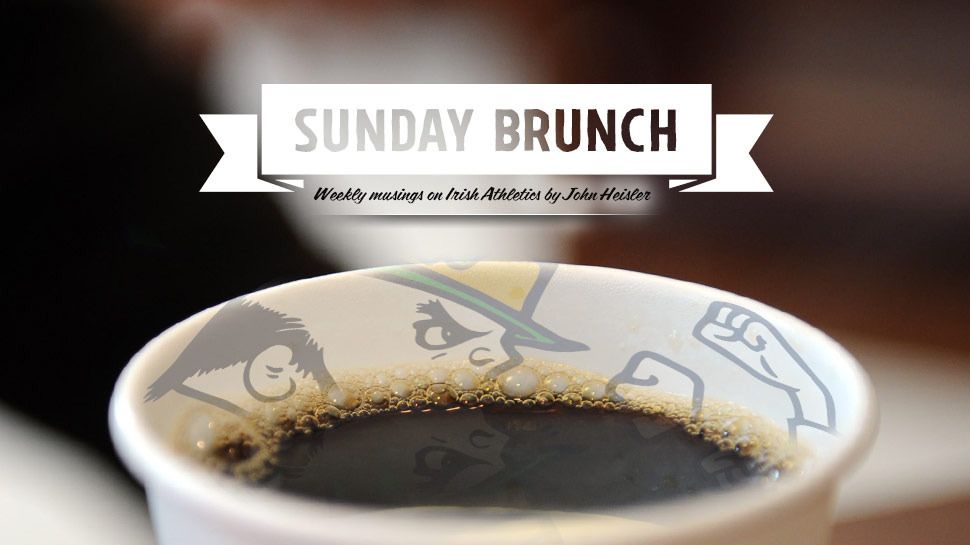Nov. 11, 2017 By John Heisler
Three new buildings surrounding Notre Dame Stadium in 2017.
More than 3,000 new premium seats, on three levels, with a dozen new elevators to help reach them.
New locations for the Notre Dame and visiting team bands.
A new locker room and separate field entrance for the visitors.
New postgame interview rooms and locations for both the Irish and the opponent.
Dedicated Notre Dame recruiting space in the Schivarelli Lounge.
Upgraded concessions areas throughout the concourses.
And with all these first-time elements, someone needed to be in charge of coordinating anything and everything that happens on Irish home football game weeks.
That person is associate athletics director Monica Cundiff, who first joined the Notre Dame athletics staff two decades ago as part of the promotions staff but has worked in the event management area now for more than a dozen years.

She qualifies as the ultimate behind-the-scenes stakeholder for Irish football weekends, yet she has her hand in virtually everything that goes on each Saturday Notre Dame plays a home game.
Wondering who coordinates details for the visiting team and its stop at Notre Dame Stadium? That’s Cundiff.
Want to know who makes certain all the right people have all the right game day credentials? That’s Cundiff.
Like to understand who ensures the game officials get in and out of the stadium and all the other places they need to go? That’s Cundiff’s job.
Thinking it must be complicated to coordinate the efforts of hundreds of ushers, Monterrey Security personnel, new Levy concessions staff and dozens more game day personnel? That’s another of Cundiff’s assignments.
The best way for the University of Illinois graduate (and former Illini women’s basketball player) to earn a blue ribbon on a given Saturday is for nothing of any major consequence to go wrong.
In her camp, no headlines is a good thing. Leave those for Brian Kelly’s football team.
Cundiff, who long has been overseeing Joyce Center events from the game management standpoint, began warming up to the football side of things two seasons ago when she spent a couple of home Saturdays shadowing former associate athletics director Mike Danch.
When Danch retired following that 2015 season, Cundiff inherited his football game manager responsibilities (she coordinates many of those details with University vice president for safety and event management Mike Seamon). But she and her staff changed little for 2016, knowing so much would be new for the 2017 campaign.
Says Cundiff, “I sat down with (vice president and athletics director) Jack (Swarbrick) and his direction was that we were going to go through so many changes from one year to the next that we just needed to see that (2016) season through. So we didn’t make any dramatic changes.”
Then, as the 2017 season approached, Cundiff and others took hard, long looks at virtually every aspect of the game management functions.
That process began with the decision to clean up the sidelines – where the combination of the presence of both team bands and the field seats in the south end zone had made for particularly crowded areas. A new credentialing system featured much greater scrutiny as to where game day employees needed to be.
“The credentialing system created a safer and more secure environment,” Cundiff says. “It gave people access to do their jobs, but it kept people off the field that didn’t need to be on the field and it kept people out of the premium seating areas unless there was a real need to be there.
“Another huge change that has benefited many people–and I think this would be something that many fans don’t even realize – is the new visiting team compound. Those teams now have their own areas that are perfect for them. They come into their own location – and everything from their locker room to their access to the field, their equipment truck, their postgame press conference, is all private and secure.”
Another big challenge new this fall involved communicating how fans accessed their seats.
“For a fan who has had season tickets for 30 years, is that still the way they should travel to their seats or is there a better way for them to go? The ticket office and the marketing department have done a great job of communicating to patrons – and especially all the fans in the premium spaces who likely had no idea where to enter the stadium. And our ability to train our staff was limited because this was still a construction zone until just prior to the start of the season.”
Cundiff’s biggest challenge to date?
“I think it’s knowing the facility,” she says. “We’ve spent a great deal of time training our own staff on how to get around. It’s customer service, it’s in cases of an emergency evacuation or if somebody falls – it’s all of that and a lot more.”
Cundiff spent the entire 2016 season involved with meetings preparing for 2017.
“Then June, July and August were crunch time and 95 percent of my days and night were focused on football, without a doubt,” she says.
Seamon works hand in hand with Cundiff, and he particularly assisted with coordinating the Monterrey Security staff which added more than 500 personnel to the game day roles, many of them assisting in the premium seating areas.
Many of Cundiff’s concerns revolve around small details that the average fan (hopefully) never notices.
“I spent nights with our band over in the stadium, figuring out what it takes to get all of them positioned up in the stands–how long it takes to come down and how long it takes to go back up,” she says. “And then they pretended to be the visiting team band, walking that pathway – and we are still perfecting that one.”
Here’s what a typical Cundiff game day Saturday looks like:
“I’m definitely here between 7:30 and 8 in the morning (for a typical 3:30 p.m. kickoff). This is the first year we’re printing credentials on site, on game day, where before the majority of our credentials would have been distributed by then. So it’s about making sure our staff is here and ready to go and the system is up and running. We’ve been producing about 1,200 credentials game to game – and on top of that would be season credentials.
“We spent a lot of time in the offseason analyzing where people needed to be on Saturdays. In the past we gave out a great many all-access credentials, and with all the new spaces this year that simply didn’t make sense.
“After that I just try to make my way around to check in with everybody–from security to NBC to concession folks, the Follett (bookstore) staff, then certainly Monterrey and the ushers.
“And there’s always something that comes up, some hiccups that take some time. Then it’s the preparation for some of the meetings. I go to a Monterrey meeting five hours prior to kickoff. Next comes a meeting with the ushers–going over any changes, any updates for the game.
“From there, the game officials are arriving so I’m meeting with the head official for a period of time. Then making sure our operational staff has shown up–those people running the clock, running the scoreboard.
“After that, the teams are arriving, typically at the same time. I welcome the Notre Dame team just like I welcome the visiting team.
“And then we conduct a meeting with the game officials, NBC, the directors of operations from both teams, our clock operators, security and Game Day. It’s just to make sure everybody is on the same page.”
Once kickoff approaches, Cundiff can be found on the field, often near the north goalposts, ready to trouble-shoot or respond as any situation dictates.
“Once the game ends the visiting team is gone within an hour, or an hour and 15 minutes,” she says. “I’m definitely not leaving that stadium until they’re gone. By that time our team is long gone and media are back working up in the press box.”
Then lights need to be turned off. Plus, a new wrinkle for 2017 involves patron access to premium seating areas for two hours following the end of each game.
The 2017 season opener against Temple involved extensive week-after debriefing meetings, including with Swarbrick and University executive vice president John Affleck-Graves. Cundiff’s Monday meetings on ensuing weeks have involved smaller, more select groups.
“That allows people to constructively talk about what and how we should be improving,” she says.

Another new wrinkle this year involves much greater amounts of setup in game day spaces because so many of the new areas in the stadium are being used during the week for other events. For example on the night before the Georgia game, every single space on three levels of premium seating on both the east and west sides was in use.
“There’s a lot of turnover that takes place from Thursday to game day with all the events that occur in all of those buildings, and that’s never happened before,” says Cundiff. “But I don’t hear anyone complaining. I think everybody has embraced the great challenge that this has been.
“And I think this is the learning year. We’re probably going to do a lot of things differently next year. But we didn’t know going into it exactly what to expect in terms of every last detail.”
The preparation for the 2017 season was helped greatly by two preseason events – one a Sunday afternoon scrimmage by the football team and the second a Friday night showing of the movie “Rudy” with students allowed to sit on the field.
“I think both those were valuable for many reasons,” says Cundiff. “Granted it added so much more work to people’s plates. However, it was a great practice–not only for planning and managing the event, but practice for the concessions folks and everybody else involved in a game day.
“That was really the first time that we had the ushers and Monterrey Security in there without construction hats. It kind of gave us a chance to go through the motions of a game for both of those two events.
“It also allowed the local community and the campus community, some of whom may never go to a football game, to actually be exposed to not only the stadium but also the new spaces and just see what all this hype has been about for the past three years.
“So I think that was a huge benefit. It could lead to someone who may not be a football fan wanting to hold a holiday party there or thinking about a wedding reception in one of the spaces.
“The student body really seemed to embrace the “Rudy” event–that was a really neat evening and it could have great potential to happen again in some form.”
In her spare time, Cundiff (a Peoria, Illinois, native) serves as the sport administrator for the Irish softball program and also coordinates the NBC Sports client hospitality program for football weekends.
The debut of all that is new and different in and around Notre Dame Stadium for 2017 has provided major challenges for plenty of people involved with Irish football contests – with Cundiff likely at or near the top of the list.
Even with a sparkling video board now in place at the south end of the field, she is perfectly happy if any given Saturday ends without her name up in lights.







